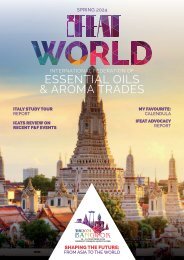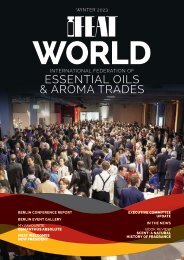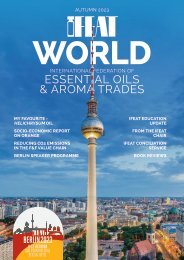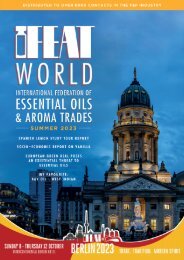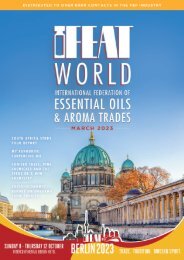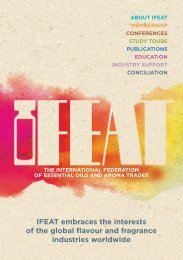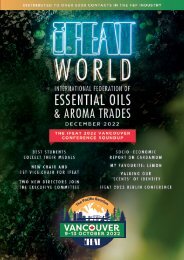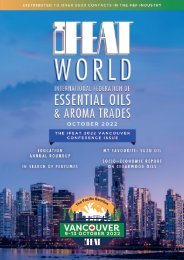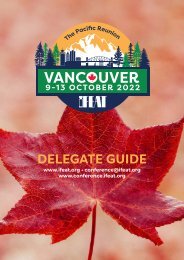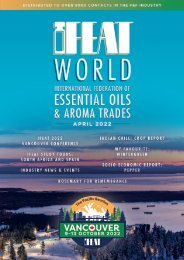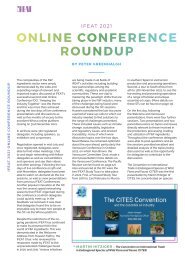IFEATWORLD July 2022
A Members' Newsletter for the International Federation of Essential Oils & Aroma Trades.
A Members' Newsletter for the International Federation of Essential Oils & Aroma Trades.
You also want an ePaper? Increase the reach of your titles
YUMPU automatically turns print PDFs into web optimized ePapers that Google loves.
18<br />
WORLD<br />
F&F INGREDIENTS:<br />
A CHANGING MARKET<br />
BY ALAIN FRIX, FOUNDER, ALLCHEMIX BV<br />
The F&F industry is probably one of the most complex industries, as it involves art,<br />
science and culture, combining the intricacies of nature and human ingenuity.<br />
F&F INGREDIENTS: A CHANGING MARKET<br />
AN ELEGANT AND<br />
IMPORTANT INDUSTRY<br />
Each of the products which compose<br />
our palette, be they natural or manmade,<br />
will drive people to purchase<br />
consumer goods which contain<br />
them: a fine perfume, a child’s<br />
lollipop, a cosmetic, a detergent<br />
for clothing, an incense stick to<br />
inspire, a refreshing beverage on<br />
a hot summer’s afternoon. Indeed,<br />
flavours and fragrances evoke a<br />
large spectrum of emotions, invisible<br />
partners in reassurance, seduction,<br />
appetites, relaxation and meditation,<br />
a conjunction between well-acting<br />
and well-being.<br />
The F&F Industry is not only about<br />
stimulating emotions, but also a<br />
significant provider of work and<br />
income to over ten million farmers<br />
worldwide as well as other people<br />
involved in transforming natural<br />
feedstock into a highly diversified<br />
offering of perfumes and flavour<br />
materials. Equally important are<br />
those technicians who spend<br />
their lives creating new synthetic<br />
molecules which have apparently<br />
been “forgotten by nature,” carrying<br />
out research guided by scientists in<br />
chemistry, biology, physics and finally<br />
IT. All these materials will fill the<br />
magician’s hat of those perfumers<br />
and flavourists who can assemble<br />
these olfactive colours into a<br />
quantum of happiness.<br />
Whether synthetics or naturals,<br />
F&F aroma ingredients are mostly<br />
relatively tiny hydrocarbon<br />
molecules. Solvents, fillers, carrier<br />
agents, preservatives or other<br />
products which do not contribute<br />
to odour or taste are excluded from<br />
this definition of aroma ingredients.<br />
Furthermore, from an ingredient<br />
standpoint, there is no universal rule<br />
- as long as regulation permits - that<br />
a fragrance ingredient could become<br />
a flavour ingredient and<br />
vice versa.<br />
QUANTIFICATION OF<br />
THE F&F INDUSTRY<br />
Many articles provide F&F industry<br />
turnover without a good indication<br />
of volumes. Moreover, turnover<br />
estimations are always subject to<br />
the price volatility of ingredients and<br />
therefore a weak indicator in volatile<br />
markets. Nature produces a biomass of<br />
hydrocarbons; it does not produce biodollars<br />
nor bio-euros. To assess F&F<br />
renewability and sustainability factors,<br />
it is necessary to estimate volumes<br />
as a key indicator, helping us to think<br />
proactively where and how to source<br />
material in the future — those pools<br />
of hydrocarbons that we will continue<br />
to tap for both synthetic and natural<br />
odouriferous substances.<br />
COMPLEXITY OF<br />
F&F INGREDIENTS<br />
There are over 1,500 main types of<br />
fragrance ingredients and over 3,000<br />
main types of flavour ingredients.<br />
Generally, each product type is<br />
available in different commercial<br />
grades or purities. Very often further<br />
specifications are required, involving<br />
detailed analysis of all components<br />
according to dozens of parameters.<br />
Manufacturers need to guarantee<br />
perfect product performance and<br />
safety in their application, and the<br />
absence of traces that could create<br />
off-notes (human sense of smell can<br />
detect traces with a very low odour<br />
threshold). It is unusual to see the same<br />
aroma ingredient being prominent<br />
in both F&F industries, often a major<br />
ingredient used in fragrances —<br />
dihydromyrcenol for example — will<br />
have a much smaller, even negligible<br />
presence in flavours. And vice versa,<br />
a sizeable flavour ingredient, such as<br />
vanillin, will likely be present only to a<br />
smaller extent in fragrances. Besides,<br />
both markets comply with different<br />
regulations (REACH for fragrances,<br />
but not for flavours, food versus skin<br />
allergens, etc.). From a structural<br />
standpoint, the fragrance market is<br />
quite globalised, while the flavours<br />
market is much more fragmented<br />
and relies more on local producers of<br />
ingredients. Cultural values start with<br />
food and tradition, the taste of your first<br />
spoonful will constitute the first steps<br />
of a long cultural journey. Quite likely,<br />
as a result, flavours reflect ethnicity<br />
even more than fragrances do. The<br />
combination of all of the above explains<br />
why the F&F world is extremely<br />
complex and this complexity is further<br />
increased with issues related to raw<br />
material availability.<br />
CERTIFICATES,<br />
REGULATIONS AND<br />
CASUALTIES<br />
In recent years, further requirements<br />
such as renewability, traceability,<br />
sustainability programmes, organic or<br />
vegan nature and compliance with the<br />
rules of a myriad of other certifying<br />
bodies have added a sizeable burden<br />
and complexity. These additional<br />
constraints have proven to be very<br />
demanding to many small producers,<br />
as they lack the personnel or expertise<br />
to complete the paperwork being<br />
requested. Ultimately many small<br />
players discontinue or sell their<br />
business to larger entities, which<br />
are facing continued consolidation<br />
themselves. The pond of F&F<br />
companies is being drained at an<br />
alarmingly fast rate as a result of<br />
excessive and often unnecessary<br />
regulations.<br />
SOURCES FOR F&F<br />
INGREDIENTS AND<br />
ESTIMATION OF<br />
USAGE LEVEL<br />
For this study, the aroma ingredients<br />
are classified into five main categories<br />
or segments. They are interconnected<br />
in complex streams of materials and<br />
these will evolve as the F&F market is<br />
exposed to new stimuli from consumer<br />
demand, regulations, technology and<br />
biomass availability. The calculations<br />
which follow are estimations of a<br />
substance’s aromatic components<br />
following correction referring to all




